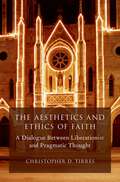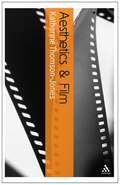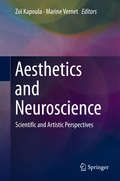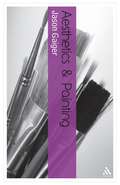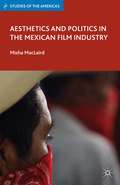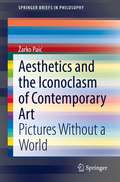- Table View
- List View
Aesthetics and Environment: Variations on a Theme
by Arnold BerleantThe essays collected in Aesthetics and Environment comprise a set of variations on art and culture guided by the theme of environment. The essays deal with the physical reality of environment such as the city, the shore, the water and the garden, but also with the virtual environment and the social one. Environmental aesthetics is a theme whose variations are as endless as the possibilities of the human performers and conditions from which it is fashioned. This enticing set of essays testifies to Berleant's special talent in moving easily between both natural and human environments and opens out the contemporary discussion beyond that of the wilderness to the cultural and social environment. Berleant argues that neither the natural nor human environment stands alone and both are best understood as distinctions that are in experience coextensive, that one can only speak of environment in relation to human experience. The theme of this book is that such experience suffuses the so-called natural world and shapes the human world. It maintains the idea that in as much as people are embedded in these worlds, relationships, including human relationships, are part of them. The melding of these two worlds leads Berleant to defend ultimately what he has termed 'social aesthetics' .
Aesthetics and Environment: Variations on a Theme
by Arnold BerleantThe essays collected in Aesthetics and Environment comprise a set of variations on art and culture guided by the theme of environment. The essays deal with the physical reality of environment such as the city, the shore, the water and the garden, but also with the virtual environment and the social one. Environmental aesthetics is a theme whose variations are as endless as the possibilities of the human performers and conditions from which it is fashioned. This enticing set of essays testifies to Berleant's special talent in moving easily between both natural and human environments and opens out the contemporary discussion beyond that of the wilderness to the cultural and social environment. Berleant argues that neither the natural nor human environment stands alone and both are best understood as distinctions that are in experience coextensive, that one can only speak of environment in relation to human experience. The theme of this book is that such experience suffuses the so-called natural world and shapes the human world. It maintains the idea that in as much as people are embedded in these worlds, relationships, including human relationships, are part of them. The melding of these two worlds leads Berleant to defend ultimately what he has termed 'social aesthetics' .
The Aesthetics and Ethics of Copying
by Darren Hudson Hick Reinold SchmückerThe Aesthetics and Ethics of Copying responds to the rapidly changing attitudes towards the use of another's ideas, styles, and artworks. With advances in technology making the copying of artworks and other artefacts exponentially easier, questions of copying no longer focus on the problems of forgery: they now expand into aesthetic and ethical legal concerns. This volume addresses the changes and provides the first philosophical foundation for an aesthetics and ethics of copying.Scholars from philosophy of art, philosophy of technology, philosophy of law, ethics, legal theory, media studies, art history, literary theory, and sociology discuss the role that copying plays in human culture, confronting the question of how-and why-copying fits into our broader system of values. Teasing out the factors and conceptual distinctions that must be accounted for in an ontology of copying, they set a groundwork for understanding the nature of copies and copying, showing how these interweave with ethical and legal concepts. Covering unique concerns for copying in the domain of artworks, from music and art to plays and literature, contributors look at work by artists including Heinrich von Kleist, Robert Rauschenberg, Courbet and Manet and conclude with the normative dimensions of copying in the twenty-first century.By bringing this topic into the philosophical domain and highlighting its philosophical relevance, The Aesthetics and Ethics of Copying establishes the complex conditions-ontological, aesthetic, ethical, cultural, and legal-that underlie and complicate the topic. The result is a timely collection that establishes the need for further discussion.
The Aesthetics and Ethics of Faith: A Dialogue Between Liberationist and Pragmatic Thought (AAR Reflection and Theory in the Study of Religion)
by Christopher D. TirresWhat is the future of liberation thought in the Americas? In this groundbreaking work, Christopher D. Tirres takes up this question by looking at the methodological connections between two quintessentially American traditions: liberation theology and pragmatism. He explains how pragmatism lends philosophical clarity and depth to some of liberation theology's core ideas and assumptions. Liberation theology in turn offers pragmatism a more nuanced and sympathetic approach to religious faith, especially its social and pedagogical dimensions. Ultimately, Tirres crafts a philosophical foundation that ensures the continued relevance of liberation thought in today's world. Keeping true to the method of pragmatism, the book begins inductively with a set of actual experiences-- the Good Friday liturgies at the San Fernando Cathedral in San Antonio, Texas-- and provides a compelling description of the way these performative rituals integrate the aesthetic and ethical dimensions of faith. Subsequent chapters probe this integration deductively at three levels of theoretical analysis: experience/metaphysics, sociality, and pedagogy. As Tirres shows, the aesthetic and ethical dimensions of faith emerge in different yet related ways at all three levels. He argues that utilizing the categories of the aesthetic and ethical enables a richer understanding of the dynamic relationship between faith and politics. This book builds new bridges between a number of discourses and key figures, and will be of interest to all who are interested in the liberatory potential of engaged faith praxis, especially when it is expressed in the form of religious ritual.
Aesthetics and Film (Bloomsbury Aesthetics)
by Katherine Thomson-JonesAesthetics and Film is a philosophical study of the art of film. Its motivation is the recent surge of interest among analytic philosophers in the philosophical implications of central issues in film theory and the application of general issues in aesthetics to the specific case of film. Of particular interest are questions concerning the distinctive representational capacities of film art, particularly in relation to realism and narration, the influence of the literary paradigm in understanding film authorship and interpretation, and our imaginative and affective engagement with film. For all of these questions, Katherine Thomson-Jones critically compares the most compelling answers, driving home key points with a wide range of film examples including Wiene's The Cabinet of Doctor Caligari, Eisenstein's October, Hitchcock's Rear Window, Kubrick's The Shining and Sluizer's The Vanishing. Students and scholars of aesthetics and cinema will find this an illuminating, accessible and highly enjoyable investigation into the nature and power of a technologically evolving art form.
Aesthetics and Film (Bloomsbury Aesthetics)
by Katherine Thomson-JonesAesthetics and Film is a philosophical study of the art of film. Its motivation is the recent surge of interest among analytic philosophers in the philosophical implications of central issues in film theory and the application of general issues in aesthetics to the specific case of film. Of particular interest are questions concerning the distinctive representational capacities of film art, particularly in relation to realism and narration, the influence of the literary paradigm in understanding film authorship and interpretation, and our imaginative and affective engagement with film. For all of these questions, Katherine Thomson-Jones critically compares the most compelling answers, driving home key points with a wide range of film examples including Wiene's The Cabinet of Doctor Caligari, Eisenstein's October, Hitchcock's Rear Window, Kubrick's The Shining and Sluizer's The Vanishing. Students and scholars of aesthetics and cinema will find this an illuminating, accessible and highly enjoyable investigation into the nature and power of a technologically evolving art form.
Aesthetics and Literature (Bloomsbury Aesthetics)
by David DaviesThe Continuum Aesthetics series looks at the aesthetic questions and issues raised by all major art forms. Stimulating, engaging and highly readable, the series offers food for thought not only for students of aesthetics, but also for anyone with an interest in philosophy and the arts. Aesthetics and Literature places philosophical aesthetics at the heart of thinking about literature. The book takes concrete examples from the traditional and contemporary literary arts and uses them to introduce all the central philosophical issues in literature. David Davies considers, with stimulating insight and great clarity, the nature of literature and fiction, artistic uses of language, and the nature of fictional characters. He goes on to explore our emotional responses to literature, the cognitive value and ethical values of literature and the accountability of the literary arts. The book offers a clear, non-technical analysis of each key issue, its broader significance and the principal positions that philosophers have taken on it. Davies presents the relevant philosophical background in a manner that is accessible to philosophy students and lay readers alike. Anyone interested in the philosophy of literature will find this book a rich source of ideas, insight and information. Combining a clear and engaging style with a sophisticated treatment of a fascinating subject, Aesthetics and Literature is a valuable contribution to contemporary aesthetics.
Aesthetics and Morality (Bloomsbury Aesthetics)
by Elisabeth SchellekensAesthetic and moral value are often seen to go hand in hand. They do so not only practically, such as in our everyday assessments of artworks that raise moral questions, but also theoretically, such as in Kant's theory that beauty is the symbol of morality. Some philosophers have argued that it is in the relation between aesthetic and moral value that the key to an adequate understanding of either notion lies. But difficult questions abound. Must a work of art be morally admirable in order to be aesthetically valuable? How, if at all, do our moral values shape our aesthetic judgements - and vice versa?  Aesthetics and Morality is a stimulating and insightful inquiry into precisely this set of questions. Elisabeth Schellekens explores the main ideas and debates at the intersection of aesthetics and moral philosophy. She invites readers to reflect on the nature of beauty, art and morality, and provides the philosophical knowledge to render such reflection more rigorous. This original, inspiring and entertaining book sheds valuable new light on a notably complex and challenging area of thought.
Aesthetics and Music (Bloomsbury Aesthetics)
by Andy HamiltonThe Continuum Aesthetics Series looks at the aesthetic questions and issues raised by all major art forms. Stimulating, engaging and accessible, the series offers food for thought not only for students of aesthetics, but also for anyone with an interest in philosophy and the arts. Aesthetics and Music is a fresh and often provocative exploration of the key concepts and arguments in musical aesthetics. It draws on the rich heritage of the subject, while proposing distinctive new ways of thinking about music as an art form. The book looks at: The experience of listening Rhythm and musical movement What modernism has meant for musical aesthetics The relation of music to other 'sound arts' Improvisation and composition as well as more traditional issues in musical aesthetics such as absolute versus programme music and the question of musical formalism. Thinkers discussed range from Pythagoras and Plato to Kant, Nietzsche and Adorno. Areas of music covered include classical, popular and traditional music, and jazz. Aesthetics and Music makes an eloquent case for a humanistic, democratic and genuinely aesthetic conception of music and musical understanding. Anyone interested in what contemporary philosophy has to say about music as an art form will find this thought-provoking and highly enjoyable book required reading.
Aesthetics and Nature: The Appreciation of Natural Beauty and the Environment (Bloomsbury Aesthetics)
by Dr Glenn ParsonsThe appreciation of nature and natural beauty demands our attention as environmental issues become ever more urgent. In this timely introduction, Glenn Parsons provides an overview of philosophical work on the aesthetics of nature, identifying key conceptual questions, clarifying central theories, and analyzing the ethical ramifications of our experience of natural beauty. Outlining five major approaches to understanding the aesthetic value of nature, this second edition explores the aesthetic appreciation of nature as it occurs in wilderness, in gardens, and in the context of appreciating environmental art. Now updated to cover recent developments in the field, it includes:· A new chapter on the sublime, the picturesque, and the beautiful· Expanded discussion of empirical and evolutionary accounts of nature appreciation, as well as the appreciation of the environment in non-Western cultures· A new chapter on the aesthetic appreciation of animals· An in-depth analysis of the appreciation of nature through cinema and photography· Discussion of the relation between environmental appreciation and climate change Combining a clear and engaging style with a sophisticated treatment of a fascinating subject, Aesthetics and Nature explores the aesthetic dimension of humanity's relationship with our physical surroundings. This a must-read for anyone who cares about nature and the future of our environment.
Aesthetics and Nature: The Appreciation of Natural Beauty and the Environment (Bloomsbury Aesthetics)
by Dr Glenn ParsonsThe appreciation of nature and natural beauty demands our attention as environmental issues become ever more urgent. In this timely introduction, Glenn Parsons provides an overview of philosophical work on the aesthetics of nature, identifying key conceptual questions, clarifying central theories, and analyzing the ethical ramifications of our experience of natural beauty. Outlining five major approaches to understanding the aesthetic value of nature, this second edition explores the aesthetic appreciation of nature as it occurs in wilderness, in gardens, and in the context of appreciating environmental art. Now updated to cover recent developments in the field, it includes:· A new chapter on the sublime, the picturesque, and the beautiful· Expanded discussion of empirical and evolutionary accounts of nature appreciation, as well as the appreciation of the environment in non-Western cultures· A new chapter on the aesthetic appreciation of animals· An in-depth analysis of the appreciation of nature through cinema and photography· Discussion of the relation between environmental appreciation and climate change Combining a clear and engaging style with a sophisticated treatment of a fascinating subject, Aesthetics and Nature explores the aesthetic dimension of humanity's relationship with our physical surroundings. This a must-read for anyone who cares about nature and the future of our environment.
Aesthetics and Nature (Bloomsbury Aesthetics)
by Glenn ParsonsAesthetics and Nature offers a clear and accessible introduction to the field of nature aesthetics. Glenn Parsons explores the current debates in the field, providing the reader with a thorough overview of the subject. The book situates nature aesthetics in relation to two principal influences: aesthetics' traditional project of understanding the value of art and current thought on the ethics of our relationship with nature. The book outlines five major approaches to understanding the aesthetic value of nature and explores the aesthetic appreciation of nature as it occurs in wilderness, in gardens, and in the context of appreciating environmental art. The book also includes a study of the idea that conserving nature's beauty provides a compelling reason to preserve wilderness. This highly topical idea has deep implications for the importance of aesthetic value in our relationship to nature, and for the fate of nature itself. Combining a clear and engaging style with a sophisticated treatment of a fascinating subject, Aesthetics and Nature is a valuable contribution to contemporary aesthetics.
Aesthetics and Neuroscience: Scientific and Artistic Perspectives
by Zoï Kapoula Marine VernetThis edited monograph provides a compelling analysis of the interplay between neuroscience and aesthetics. The book broaches a wide spectrum of topics including, but not limited to, mathematics and creator algorithms, neurosciences of artistic creativity, paintings and dynamical systems as well as computational research for architecture. The international authorship is genuinely interdisciplinary and the target audience primarily comprises readers interested in transdisciplinary research between neuroscience and the broad field of aesthetics.
Aesthetics and Painting (Bloomsbury Aesthetics)
by Jason GaigerAesthetics and Painting introduces and opens up current debates and ideas in the aesthetics of painting. At the book's center is an investigation of the complex relationship between what a painting depicts and the means by which it is depicted. The book looks at: how and why painting may be distinguished from other art forms; the relationship between the painted surface and the depicted subject; the "rules of representation" specific to painting; abstract art and nonrepresentational painting; the most recent technological and aesthetic developments and their implications; the role of the artist-and that of the spectator. A sophisticated treatment of major ideas in art and philosophy, Aesthetics and Painting remains highly readable throughout, offering a clear and coherent account of the nature of painting as an art form.
Aesthetics and Painting (Bloomsbury Aesthetics)
by Jason GaigerAesthetics and Painting introduces and opens up current debates and ideas in the aesthetics of painting. At the book's center is an investigation of the complex relationship between what a painting depicts and the means by which it is depicted. The book looks at: how and why painting may be distinguished from other art forms; the relationship between the painted surface and the depicted subject; the "rules of representation" specific to painting; abstract art and nonrepresentational painting; the most recent technological and aesthetic developments and their implications; the role of the artist-and that of the spectator. A sophisticated treatment of major ideas in art and philosophy, Aesthetics and Painting remains highly readable throughout, offering a clear and coherent account of the nature of painting as an art form.
Aesthetics And Political Culture In Modern Society (Routledge Innovations In Political Theory Series (PDF))
by Henrik Kaare NielsenDo aesthetic appeals to senses and emotions in political debate necessarily marginalise political reason and reduce citizens to consumers – thus dangerously undermining democracy? Or is sensuous-emotional engagement, on the contrary, a basic fact of the political process and a crucial precondition for revitalising democracy? Aesthetics and Political Culture in Modern Society investigates the current interrelationship between aesthetic practice and political practice in Western democracies, focusing on its impact on democratic political culture. Henrik Kaare Nielsen argues that aesthetic interventions in the political process do not by definition undermine politics’ content of reason. Instead, a differentiation must be made between a multiplicity of aesthetic forms of intervention – some of which tend to weaken the political judgement of citizens while other forms tend to stimulate competent judgement. This book will be of interest to scholars in the fields of political science, sociology, media studies, and cultural studies.
Aesthetics and Political Culture in Modern Society (Routledge Innovations in Political Theory)
by Henrik Kaare NielsenDo aesthetic appeals to senses and emotions in political debate necessarily marginalise political reason and reduce citizens to consumers – thus dangerously undermining democracy? Or is sensuous-emotional engagement, on the contrary, a basic fact of the political process and a crucial precondition for revitalising democracy? Aesthetics and Political Culture in Modern Society investigates the current interrelationship between aesthetic practice and political practice in Western democracies, focusing on its impact on democratic political culture. Henrik Kaare Nielsen argues that aesthetic interventions in the political process do not by definition undermine politics’ content of reason. Instead, a differentiation must be made between a multiplicity of aesthetic forms of intervention – some of which tend to weaken the political judgement of citizens while other forms tend to stimulate competent judgement. This book will be of interest to scholars in the fields of political science, sociology, media studies, and cultural studies.
Aesthetics and Political Culture in Modern Society (Routledge Innovations in Political Theory)
by Henrik Kaare NielsenDo aesthetic appeals to senses and emotions in political debate necessarily marginalise political reason and reduce citizens to consumers – thus dangerously undermining democracy? Or is sensuous-emotional engagement, on the contrary, a basic fact of the political process and a crucial precondition for revitalising democracy? Aesthetics and Political Culture in Modern Society investigates the current interrelationship between aesthetic practice and political practice in Western democracies, focusing on its impact on democratic political culture. Henrik Kaare Nielsen argues that aesthetic interventions in the political process do not by definition undermine politics’ content of reason. Instead, a differentiation must be made between a multiplicity of aesthetic forms of intervention – some of which tend to weaken the political judgement of citizens while other forms tend to stimulate competent judgement. This book will be of interest to scholars in the fields of political science, sociology, media studies, and cultural studies.
Aesthetics and Politics in the Mexican Film Industry (Studies of the Americas)
by M. MacLairdEvaluating a broad selection of Mexican films produced from the early 1990s to the present, this study examines how production methods, audience demographics, and aesthetic approaches have changed throughout the past two decades and how these changes relate to the country's transitions to a democratic political system and a free-market economy.
Aesthetics and subjectivity
by Andrew BowieNew, completely revised and re-written edition. Offers a detailed, but asccesible account of the vital German philosophical tradition of thinking about art and the self. Looks at recent historical research and contemporary arguments in philosophy and theory in the humanities, following the path of German philosophy from Kant, via Ficthe and Holderlin, the early Romantis, Schelling, Hegel, Scleimacher, to Nietzsche. Develops the approaches to subjectivity, aesthetics, music and language in relation to new theoretical developments bridging the divide between the continental and analytical traditions of philosophy. The huge growth of interest in German philosophy as a resource for re-thinking both literary and cultural theory, and contemporary philosophy will make this an indispensible read.An electronic edition of this book is freely available under a Creative Commons (CC BY-NC-ND) licence.
Aesthetics and subjectivity
by Andrew BowieNew, completely revised and re-written edition. Offers a detailed but accessible account of the vital German philosophical tradition of thinking about art and the self. Looks at recent historical research and contemporary arguments in philosophy and theory in the humanities, following the path of German philosophy from Kant, via Fichte and Holderlin, the early Romantics, Schelling, Hegel, Schleiermacher, to Nietzsche. Develops the approaches to subjectivity, aesthetics, music and language in relation to new theoretical developments bridging the divide between the continental and analytical traditions of philosophy. The huge growth of interest in German philosophy as a resource for re-thinking both literary and cultural theory, and contemporary philosophy will make this an indispensable read.An electronic edition of this book is freely available under a Creative Commons (CC BY-NC-ND) licence.
Aesthetics and the Embodied Mind: Beyond Art Theory and the Cartesian Mind-Body Dichotomy (Contributions to Phenomenology #73)
by Alfonsina ScarinziThe project of naturalizing human consciousness/experience has made great technical strides (e.g., in mapping areas of brain activity), but has been hampered in many cases by its uncritical reliance on a dualistic “Cartesian” paradigm (though as some of the authors in the collection point out, assumptions drawn from Plato and from Kant also play a role). The present volume proposes a version of naturalism in aesthetics drawn from American pragmatism (above all from Dewey, but also from James and Peirce)—one primed from the start to see human beings not only as embodied, but as inseparable from the environment they interact with—and provides a forum for authors from diverse disciplines to address specific scientific and philosophical issues within the anti-dualistic framework considering aesthetic experience as a process of embodied meaning-making. Cross-disciplinary contributions come from leading researchers including Mark Johnson, Jim Garrison, Daniel D. Hutto, John T. Haworth, Luca F. Ticini, Beatriz Calvo-Merino.The volume covers pragmatist aesthetics, neuroaesthetics, enactive cognitive science, literary studies, psychology of aesthetics, art and design, sociology.
Aesthetics and the Environment: The Appreciation of Nature, Art and Architecture
by Allen CarlsonTraditional aesthetics is often associated with the appreciation of art, Allen Carlson shows how much of our aesthetic experience does not encompass art but nature, in our response to sunsets, mountains or horizons or more mundane surroundings, like gardens or the view from our window.He argues that knowledge of what it is we are appreciating is essential to having an appropriate aesthetic experience and that scientific understanding of nature can enhance our appreciation of it, rather than denigrate it.
Aesthetics and the Environment: The Appreciation of Nature, Art and Architecture
by Allen CarlsonTraditional aesthetics is often associated with the appreciation of art, Allen Carlson shows how much of our aesthetic experience does not encompass art but nature, in our response to sunsets, mountains or horizons or more mundane surroundings, like gardens or the view from our window.He argues that knowledge of what it is we are appreciating is essential to having an appropriate aesthetic experience and that scientific understanding of nature can enhance our appreciation of it, rather than denigrate it.
Aesthetics and the Iconoclasm of Contemporary Art: Pictures Without a World (SpringerBriefs in Philosophy)
by Žarko PaićThe main themes and aims of this book are understanding aesthetics, contemporary art and the end of the avant-garde not from the traditional viewpoint of the metaphysics of the beautiful and the sublime but rather thru close connection to the techno-genesis of virtual worlds. This book tackles problems in contemporary art theory such as the body in space and time of digital technologies, along with other issues in visual studies and image science. Further intentions exhibit the fundamental reasons for the disappearance of the picture in the era of virtual reality starting from the notion of contemporary art as realized iconoclasm; art has no world for its "image". The author argues that the iconoclasm of contemporary art has severe consequences. This text appeals to philosophers of art and those interested in contemporary art theory.


